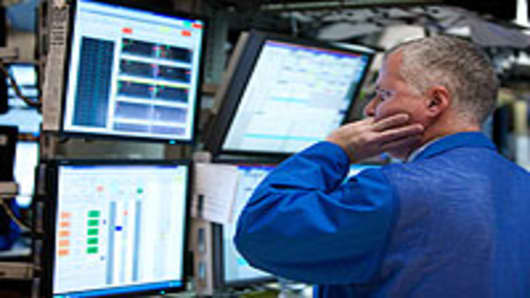As strange as it might seem, the eight-month-old stock rally may just keep going because so many investors still think it won't last.
Investment advisors say clients continue to view stocks with hesitancy and skepticism—a vestige of the panic that swept through the markets just a year ago. But that fear, ironically, has kept stocks from going up too far, too fast—allowing the market to move gradually higher as investors creep timidly back into stocks.
"We're seeing a lot of evidence that they're buying this rally with a lot of apprehension,"says Richard Sparks, senior analyst at Schaeffer's Investment Research in Cincinnati. "We would interpret that pessimism and apprehension in a positive way."
As major indexes continue to reach fresh highs—the crossing Monday of 1100 on the Standard & Poor's 500 marks the latest hurdle—conviction that the rally can keep going builds.
"The buying's not getting out of hand. The more controlled a rally is, the more sustainable it is," says Sparks, who expects small- and mid-cap technology to lead the market. "At least in terms of earnings and the economic numbers that are coming out, I would expect we should see a strong, steady rally to continue through at least year's end."
Market watchers are eyeing a few key milestones coming up as tests for the rest of 2009, a year that began with freefalling stocks and looks to end with a better than 60 percent rally.
This is an options expiration week, which a year ago was bad for the market and saw a sharp drop. But seven of the past 12 options expirations weeks have seen gains.
Also, technicians are looking at S&P 1120 as a key level because it represents a two-thirds rebound off the March lows when the broad-based market gauge hit an intraday low of 666.
Should the market pass both tests, that could give a boost to investors' spirits and pave the way for a solid run to close out the year.
"It is difficult to understand why 10,291 on the Dow Jones Industrial Average, which was the close on November 11, can make people feel better about stocks than 9,802, which was the close on Nov. 4," managers at Al Frank Investment Management, a value-based firm in Laguna Beach, Calif., wrote in an analysis this week.
"Seems logical that the less expensive stocks are, the more attractive they would be, but such is not always the case with fear and greed playing such a huge role in investor sentiment."
Questions over market volume persist, though, as portfolio managers continue to try to protect clients' interests and as much of the trading seems to be driven by institutional influences rather than retail investors.
The lack of volume as well as weak breadth—the measure of gainers over losers—is feeding some fear that a substantial correction looms before the market can continue its path to new highs.
"Current volume patterns are a sign of money shifting from strong hands to weak hands ..." BofA Merrill Lynch said in a research note Monday. "This condition can remain in place for weeks, if not months, causing choppy equity markets. The key message the market is signaling, in our view, is this is a maturing rally, not the early stages of one."
The firm warned that the market could see a correction that would send the S&P to 935, albeit a constructive move that would pave the way to a 1200-1325 range for 2010.
An additional worry is over dollar trends.
The US currency's sharp decline has been seen as the lynchpin of the stock market rally. But some analysts fear that the greenback is approaching a point of diminishing returns where further weakness will start to sap confidence in the market.
"Eventually the dollar's going to get to a level where it's going to be bad for the markets," says Dave Rovelli, managing director of US equity trading at Canaccord Adams.
Rovelli sees that coming should the dollar index (track the gauge here) hit 70—a steep decline considering that the level is currently just above 75. But with government officials showing no indication that strong-dollar policies are forthcoming, the currency's decline at least in some measure is virtually assured.
At least for the moment—and likely through the end of the year—there's little indication anyone is willing to stand in front of the Wall Street freight train.
"The key question at this point is whether new leadership will emerge. Will volume and breadth come to confirm this rally, or are we nearing a near-term peak here?" says Gary Flam, portfolio manager at Bel Air Investment Advisors in Los Angeles.
"At this point it's too early to say the market is topping...I'm being cautious about the market at these levels. I'm not looking to invest heavily and jump into the deep end on the risk perspective. I'm still hanging out in the shallow end."



